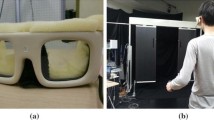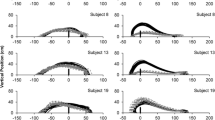Abstract.
One of the goals of this study was to examine the nature and role of distant visual information sampled during locomotion in the feedforward control of leading and trailing limb while an individual is required to step over an obstacle in the travel path. In addition we were interested in whether or not on-line visual information available while the limb (lead or trail) is stepping over the obstacle influences limb trajectory control and whether the information provided during lead limb cross would be used to calibrate movement of the trail limb. Towards this end, we manipulated availability of vision following an initial dynamic sampling period during the approach phase in proximity to the obstacle and during the lead and trail limb stepping over the obstacle. Ten participants completed 40 trials of obstacle crossing in 8 testing conditions. Initial dynamic visual sampling was sufficient to ensure successful task performance in the absence of vision in the approach phase and during both lead and trail limb stepping over the obstacle. Despite successful task performance, foot placement of the lead and trail limb before obstacle crossing and limb elevation over the obstacle were increased after withdrawal of vision in the approach area. Furthermore, the correlation between toe clearance and foot placement was diminished. While both limbs require feedforward visual information to control the step over the obstacle, only lead limb elevation was influenced by availability of on-line visual information during obstacle crossing. Results were in agreement with the notion of primacy of information inherent in the optic array over those from static samples of the environment in guiding locomotion. It is suggested that the expected proprioceptive feedback information associated with the limb posture before the obstacle, reconstructed using visual memory from dynamic sampling of the environment, mismatched with those from the actual limb position. Accordingly, participants adopted a different strategy that enabled them to clear the obstacle with a higher safety margin.




Similar content being viewed by others
References
Austin GP, Garrett GE, Bohannon RW (1999) Kinematic analysis of obstacle clearance during locomotion. Gait and Posture 10:109–120
Chou L, Draganich LF (1998) Placing the trailing foot closer to an obstacle reduces flexion of the hip, knee, and ankle to increase the risk of tripping. J Biomech 31:685–691
Drew T, Jiang W, Kably B, Lavoie S (1996) Role of the motor cortex in the control of visually triggered gait modifications. Can J Physiol Pharmacol 74:426–442
Gibson JJ (1958) Visually controlled locomotion and visual orientation in animals. Br J Psychol 49:182–194
Greig MA, Green JP, Patla AE (2003) Why do we fail when approaching and stepping over an obstacle after vision was removed five steps before? In: Lord SR, Menz HB (eds) The International Society for Postural and Gait Research: posture and gait throughout the lifespan. Sydney, Australia, pp 128
Hill SW, Patla AE, Ishac MG, Adkin AL, Supan TJ, Barth DG (1997) Kinematic patterns of participants with a below-knee prosthesis stepping over obstacles of various heights during locomotion. Gait Posture 6:186–192
Laurent M, Thomson JA (1991) Anticipation and control in visually-guided locomotion. Int J Sport Psychol 22:251–276
Lee DN, Lishman JR, Thomson JA (1982) Regulation of gait in long jumping. J Exp Psychol Hum Percept Perform 8:448–459
Montagne G, Cornus S, Glize D, Quaine F, Laurent M (2000) A perception-action coupling type of control in long jumping. J Mot Behav 32:37–43
Patla AE (1997) Understanding the roles of vision in the control of human locomotion. Gait Posture 5:54–69
Patla AE (1998) How is human gait controlled by vision? Ecol Psychol 10:287–302
Patla AE, Rietdyk S (1993) Visual control of limb trajectory over obstacles during locomotion: effect of obstacle height and width. Gait Posture 1:45–60
Patla AE, Vickers JN (1997) Where and when do we look as we approach and step over an obstacle in the travel path? Neuroreport 8:3661–3665
Patla AE, Rietdyk S, Martin C, Prentice S (1996) Locomotor patterns of the leading and the trailing limbs as solid and fragile obstacles are stepped over: some insights into the role of vision during locomotion. J Mot Behav 28:35–47
Patla AE, Niechwiej E, Racco V, Goodale MA (2002) Understanding the contribution of binocular vision to the control of adaptive locomotion. Exp Brain Res 142:551–561
Perry SD, Patla AE (2001) On-line adjustments to body center of mass and limb elevation to suddenly changing obstacle height. In: Duysens J, Smits-Engelsman BM, Kingma H (eds) Control of posture and gait. Maastricht, Netherlands, pp 485–487
Author information
Authors and Affiliations
Corresponding author
Additional information
Financial assistance was provided by a grant from the Office of Naval Research, USA, NSERC/Canada, and CAPES/Brazil. We would like to thank Milad G. Ishac, Mike Greig, Zinat Shafaei-Shirazi, and Candida T. Goncalves for their assistance
Rights and permissions
About this article
Cite this article
Mohagheghi, A.A., Moraes, R. & Patla, A.E. The effects of distant and on-line visual information on the control of approach phase and step over an obstacle during locomotion. Exp Brain Res 155, 459–468 (2004). https://doi.org/10.1007/s00221-003-1751-7
Received:
Accepted:
Published:
Issue Date:
DOI: https://doi.org/10.1007/s00221-003-1751-7




